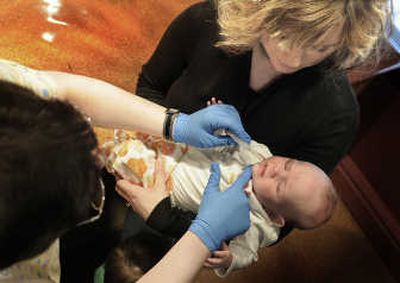Progress on vaccinations, but still below average

Chickenpox outbreaks at several Spokane schools have highlighted a stubborn problem for regional public health officials: how to convince more parents that immunizing children is the safest way to protect young lives.
Seven in 10 children across Washington have been vaccinated – a number that represents the best progress over the past five years of any state, but which remains below the national average and federal goals, state Secretary of Health Mary Selecky said.
“Public health is as much about communication as it is about good science,” Selecky said in discussing the challenges of boosting immunization rates.
Western states are often poorer, more rural and more suspicious of vaccines than those with high immunization rates such as Massachusetts and Connecticut.
Childhood vaccines not only protect against the deadly diseases that continue to kill children across the world, they also offer protection for the elderly who are more susceptible, acting Spokane public health officer Dr. Larry Jecha said.
“We need people to start thinking about the safety of the community, including grandpas and grandmas, when we discuss vaccines,” Jecha said.
He recalled the measles outbreak from 1989 to 1991 that resulted in 55,000 cases in the United States and the deaths of 123 people. In the Tri-Cities area, the outbreak infected 123 people and killed three.
Measles remain a concern following a recent outbreak in San Diego. Dr. Anne Schuchat, director of the National Center for Immunization and Respiratory Diseases for the Centers for Disease Control and Prevention, said global health officials consider it “a huge success story” that the scourge of measles deaths around the world has dropped by 68 percent, from 757,000 deaths a year in 2000, to an estimated 242,000 deaths in 2006.
Selecky called the often painful shots “medical miracles” that have turned many of the most widespread, deadly diseases into memories.
To underscore Washington’s progress during National Infant Immunization Week, Schuchat recounted the protections offered by the 16 inoculations children are encouraged to have by the time they reach age 18.
“We know parents today sometimes don’t think about the old diseases,” she said. “They don’t seem real because we don’t see them. But they are still around and we need to remain diligent.”
Schuchat said infants not yet vaccinated are the most vulnerable to disease. An older, unvaccinated child in the home, at school or at a pediatrician’s office can pose a threat to babies.
Inconvenience can be a factor in children not being vaccinated. Jecha said that’s the case in Spokane, where children without vaccinations were sent home during the chickenpox outbreaks.
That proved more of an inconvenience, and all parents but one either dug out immunization records or had their children vaccinated, he said.
Schuchat acknowledged the fears of parents who suspect a link between autism and vaccines. “All we can say is that the science, in our judgment, doesn’t support that conclusion.”